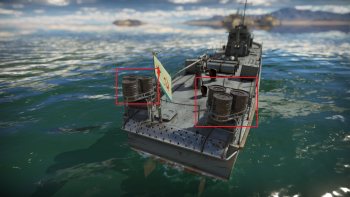BB-1 depth charge
Contents
Description
The BB-1 depth charge (Russian: Бомба Большая (Глубинная), Large bomb (depth) ) is a larger version of the BM-1 (Russian: Бомба Малая (Глубинная), Small bomb (depth)) and is present in War Thunder on naval vessels belonging to USSR.
Depth charge mechanics in War Thunder are very basic, being simple, medium-sized bombs deployed from naval vessels. Their area of effect is almost precisely vertically upwards, somewhat alike torpedoes, except depth charges, do not move from their deployed location except to sink.
Vehicles equipped with this weapon
| Vehicles equipped with this weapon | |
|---|---|
| Motor torpedo boats | Pr. 206 · D-3 · Pr.123K · Pr.123K (A-10bis) · Pr.183 · Pr. 206 |
| Sub-chasers | BMO · MO-4 · MPK pr.122A · MPK Pr.122bis · MPK-163 · OD-200 · Groza |
| Destroyers | Soobrazitelny · Stroyny · Ognevoy |
General info
Tell us about the tactical and technical characteristics of the bomb.
Effective damage
The depth charges produce focused splash damage right above their location, like a vertical torpedo. Although originally they were designed to produce both explosive and shockwave damage underwater to destroy submarines, in War Thunder, there are no submarine vehicles and as a result, the depth charges have a very focused area of effect.
Comparison with analogues
The depth charges are comparable to static torpedoes which explode after a time delay. Numbers-wise, the BB-1 depth charges are comparable to a 150 kg bomb.
Usage in battles
Depth charges require much more skill to serve any purpose in comparison to torpedoes, due to the fact you either have to be very close to the opponent or you have to predict the path the opponents may take.
An important aspect of using depth charges is to set its activation time (depth charges do not have proximity fuses). You can set the activation time before battle, whenever you have depth charges installed. It is recommended to use some time in the middle (5-8s) to allow some variety, but if you know that you are going to face faster boats (earlier tiers) or slower, larger boats (later tiers), then you can use a faster activation time (3-5s) or a slower activation time (7-10s) respectively.
There two main strategies for using depth charges in battle: 1) cutting in-front of enemies and planting depth charges, usually in a motorboat; 2) planting depth charges around the perimeter of a strategic point before enemies pass through. The former strategy can be adapted to suit close-quarter battles when the opponent is right up against your side where you can plant the depth charge and hope that the splash damage hull-break the opponent; the latter strategy requires an above-average game sense and knowledge of the map.
Pros and cons
Summarise and briefly evaluate the weaponry in terms of its characteristics and combat effectiveness. Mark pros and cons as a list.
Pros:
- Very powerful weapon when used strategically
- Can have a time delay from 3 to 10 seconds, allowing for a variety of uses (short-term grenade placed in-front of opponents or more long-term strategic 'mine' placement)
Cons:
- Difficult to use effectively, due to its 'static' nature
History
Describe the history of the creation and combat usage of the weapon in more detail than in the introduction. If the historical reference turns out to be too long, take it to a separate article, taking a link to the article about the weapon and adding a block "/ History" (example: https://wiki.warthunder.com/(Weapon-name)/History) and add a link to it here using the main template. Be sure to reference text and sources by using <ref></ref>, as well as adding them at the end of the article with <references />.
Media
An excellent addition to the article would be a video guide, as well as screenshots from the game and photos.
See also
Links to the articles on the War Thunder Wiki that you think will be useful for the reader, for example:
- reference to the article about the variant of the weapon;
- references to approximate analogues by other nations and research trees.
External links
Paste links to sources and external resources, such as:
- topic on the official game forum;
- encyclopedia page on the weapon;
- other literature.
| Naval depth charges | |
|---|---|
| USA | Mk.6 · Mk.6 mortar · K-gun Mk.9 |
| Germany | WBD · WBF · WBG |
| Foreign: | BB-1 (USSR) · Mk.6 (USA) · Type 95 (Japan) |
| USSR | BB-1 · BM-1 · MBU-600 mortar · RBM mortar |
| Britain | Limbo mortar · Mk.10 Hedgehog mortar · Mk.VII · Y-gun Mk.VII |
| Foreign: | Mk.6 mortar (USA) |
| Japan | Type 3 · Type 95 |
| Foreign: | Mk.6 mortar (USA) · Mk.9 (USA) · Mk.10 Hedgehog (Britain) |
| Italy | B TG · B TG 100 · BAS · Mk.4 |
| Foreign: | WBG (Germany) · Mk.10 Hedgehog (Britain) |
| France | Guiraud |
| Foreign: | Mk.VII (Britain) · Y-gun Mk.VII (Britain) |





